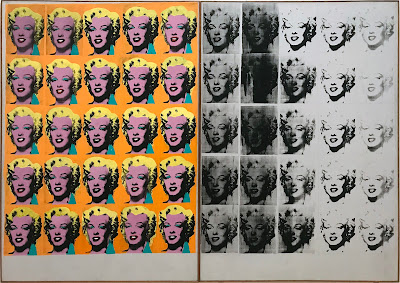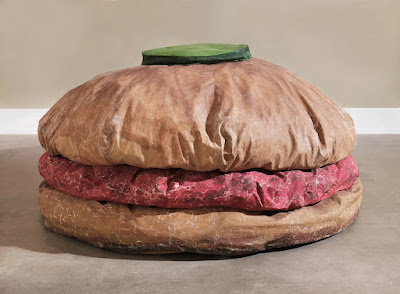50. Pop Art
“In aristocratic societies, rich people used to commission exquisite paintings for their walls. Years later, cheap imitations would filter down to calendars in gas stations. In our democratic society, this works backwards. Here, art begins as the kind of picture you'd find on a matchbook cover. Then expensive imitations of it wind up on the walls of plastic surgeons and Hollywood agents.” – Brad Holland
What was it about? What were the goals?
Pop Art was a branch of the river of Post Modernism. The easiest way to understand this period, at least originally, is as a protest of modernism, especially Abstract Expressionism. Where that artform was wildly abstract and highly personal, pop art was representational, and completely impersonal. And, as stated in previous lessons, while Modernism was a serious attempt at bold new design and innovation, based on the optimism of the new modern age (democracy, modern technology and capitalism), Pop Art took an equally bold look at the failings and moral turpitude of modern civilization.
That isn't to say Pop Art didn't borrow ideas from the modernists - artists like Robert Rauschenberg and Jasper Johns enjoyed adding found objects into their work (like the Dadaists did before), and certainly employed some loose, abstract brushwork of their own. Andy Warhol enjoyed creating collaged compositions, highly reminiscent of Matisse's collages.
Pop Art was many things, but a central feature was the appropriation of mass culture imagery - celebrity photos, logos, banal "low art" and illustration, which were taken and combined in ironic ways. Part of it had to do with exposing and critiquing the uglier side of mass culture. Artists like Andy Warhol would show images of all sorts of things, from Marilyn Monroe's face to car crashes, printed multiple times on a canvas, as a commentary on how everything in modern society has become a product, to be mass produced and consumed. The fact he also made "dyptychs", referencing Christian art, served to show how modern society worships celebrities and celebrity status.
Warhol often superimposed company logos over images of famous people and scenes - even Da Vinci's Last Supper:
In many ways, Pop Art succeeded in shocking and offending traditional conservative values. Shock value was central to Pop Art's themes and aesthetics.
But, it wasn't all ironic and cynical. Pop artists saw and accepted capitalism as part of the system they lived in, and they wanted to play the game, and win - a motivation that set them apart from some of the more radical conceptual artists of the time. While other artists were recording and performing art that couldn't be sold, Pop Artists were mass producing canvases, getting their work into galleries and accepting commissions non-stop. Andy Warhol saw at least some form of honesty and equality created by modern capitalism. He once said, "A Coke is a Coke and no amount of money can get you a better Coke than the one the bum on the corner is drinking. All the Cokes are the same and all the Cokes are good. Liz Taylor knows it, the President knows it, the bum knows it, and you know it."
There was also a love of the celebrity, a capitalist creation that allowed people to attain a kind of immortality - a name and legacy that would remain long after death. Andy Warhol, the greatest of the Pop Artists, promoted the notion of celebrity in all his work, but especially in a series of underground films in which he filmed strangers (anyone who came in off the street) for 15 minutes each. Warhol even bought two theatres in NYC to play his films non-stop, allowing people their "15 minutes of fame."
A bit of historical context:
The underlying philosophy of the movement:
Much of this question has already been explained above - the goals and interests of pop artists. Without being redundant, one could debate whether the purpose of Pop Art was to elevate low culture into fine art, or to debase high art, making it a lowly commodity. Pop Art certainly did both. It also served as a way to critique the modern world - not a new idea. Romantics also wanted to critique society with their art, but whereas those artists seemed to be teaching lessons to make the world a better place, Pop Artists seem more cynical and comical. Like much of post modernism, it's best understood as a series of jokes.
How was it represented in the other arts – music, architecture, and literature?
Andy Warhol produced and directed a number of experimental films, which he played at two theatres that he bought in NYC: The New Andy Warhol Garrick Theater and the 55th Street Playhouse. He also wrote several books, founded magazines, produced several short-lived TV shows. He tried as best he could to create a multi-media brand. While his films were not successful initially, never getting major financing, they are played at museums today. His magazine Interview is still in operation today.
The movement also created a new fashion style for everyday consumer items, electronics and appliances to make them more artistic, colorful, and extreme. Pop art in fashion and design had to do with spicing up the drab, simple designs of the minimalist movement, which had come before.
Was it great?
Yes? I mean, obviously, greatness is relative. Compared to the work of Michelangelo or Rembrandt, there's no comparison, that's like apples and oranges. And, many have complained about Pop Art's use of appropriation (borrowing or stealing images) as being unoriginal and uncreative. It also led to several large law suits where artists like Warhol used other people's art (without permission) to make large sums of money.
And then, it's true that most Pop Art is fairly easy to replicate - once you see how they did it, anyone could paint a Lichtenstein, or a Haring, or print a Warhol - and indeed, many people have. It's hard to know when you do an image search on Google, what's an original artwork and what's in that style, but made by someone else. Forgeries are also common.
Those are facts. Then there's what Pop Artist Richard Hamilton wrote about Pop Art:
"Pop Art is: Popular (designed for a mass audience), Transient (short-term solution), Expendable (easily forgotten), Low cost, Mass produced, Young (aimed at youth), Witty, Sexy, Gimmicky, Glamorous, Big business."
It's not the most glowing endorsement of his own movement. But, having said all that, there is a certain genius in Pop Art, in the humor they found. And, they did care about beauty, it shows in their work. And, in a way, they were right about how pop culture is worth examining - it can tell us about ourselves as individuals and as a culture. At its best, artists like Haring used their work and celebrity status to address important social issues, like the HIV epidemic in the 1980s.
Some leading figures:
Wayne Thiebaud (American, 1920-2021)
Roy Lichtenstein (American, 1923-1997)
Sir Eduardo Paolozzi (Scottish, 1924-2005)
Robert Rauschenberg (American, 1925-2008)
Andy Warhol (Slovak-American, 1928-1987)
Claes Oldenburg (Swedish-American, 1929-2022)
Yayoi Kusama (Japanese, 1929-)
Niki de Saint Phalle (French, 1930-2002)
Jasper Johns (American, 1930-)
R.B. Kitaj (Hungarian-American, 1932-2007)
Billy Apple (New Zealand-American, 1935-2021)
David Hockney (British-American, 1937-)
Pauline Boty (British, 1938-1966)
Some of the most famous artworks of the time:





























%20on%20Caterpillar%20Tracks%20AP.jpg)






















Comments
Post a Comment